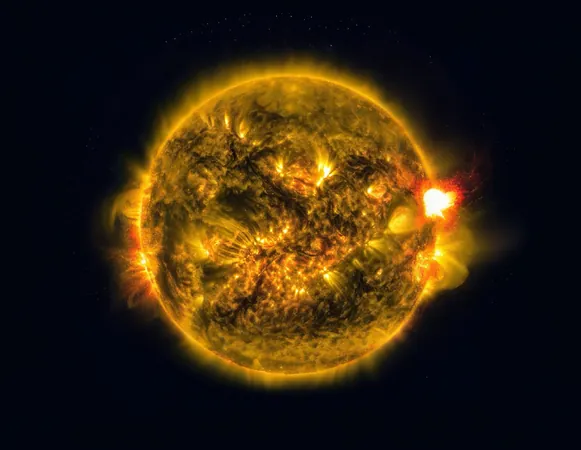
Shocking Discovery: Solar Flares Are WAY Hotter Than We Imagined!
2025-09-04
Author: Emily
The Fiery Nature of Solar Flares
Solar flares are nature's explosive fireworks, unleashing torrents of magnetic energy that can supercharge Earth's upper atmosphere, disrupt radio signals, and pose serious threats to satellites and astronauts in space.
The Mystery of Extreme Heat
For decades, scientists have grappled with the intense heat generated during solar flares, but a puzzling question remained: why do certain particles heat up differently, and why do their spectral fingerprints often appear 'too wide'? This enigma has puzzled researchers since the 1970s.
A Groundbreaking Study Reveals the Truth
A revolutionary study led by Alexander Russell at the University of St Andrews has shed new light on this mystery. The research reveals that during solar flares, ions become significantly hotter than electrons—about 6.5 times hotter, with temperatures potentially exceeding a staggering 60 million degrees Kelvin!
This remarkable finding explains why flare emission lines appear broader than expected, negating the need for complicated turbulence theories.
Understanding Solar Plasma
Solar plasma consists of a chaotic mix of charged particles, including lightweight negatively charged electrons and much heavier positively charged ions, such as iron and calcium. Traditionally, scientists assumed electrons and ions quickly equalized in temperature, a neat but misleading simplification.
How Magnetic Reconnection Plays a Role
The study also highlights 'magnetic reconnection,' a process where stressed magnetic field lines snap and rapidly reconnect, leading to significant heating of ions compared to electrons. This phenomenon has been observed across different space environments, reinforcing its universal nature.
The Implications of Hot Ions
Russell’s team predicts that during a flare's early moments, particularly above the hot plasma loops, ion temperatures can initially spike dramatically. This rapid heating leaves a distinctive mark on the flare’s spectrum, causing spectral lines to widen—previously attributed to turbulence, but now understood to result from super-hot ions.
A Solution to an Astrophysics Riddle
The beauty of this new perspective lies in its simplicity. By demonstrating that ions get much hotter than electrons at the onset of flares, Russell's findings provide a cohesive explanation for a long-standing mystery in astrophysics. The disparity in temperatures alters the dynamics, ensuring that ion-heavy heating significantly influences the observed spectral lines and ultimately how we interpret solar activity.
Changing the Landscape of Solar Research
This pivotal discovery has the potential to reshape our understanding of solar flares. It suggests a fresh approach to interpreting observations, urging researchers to study how ion and electron temperatures evolve separately, especially in the critical early moments of flare activity.
The Importance for Space Weather Forecasting
Understanding the different heating dynamics between ions and electrons is crucial for space weather forecasts, which rely on how hot and fast flare plasmas can disrupt Earth’s ionosphere and affect satellite operations. A better grasp on these phenomena could predict the intensity of solar events and their subsequent impact.
A New Era for Solar Physics
With this groundbreaking study published in The Astrophysical Journal Letters, Russell and his colleagues have opened a new chapter in solar physics, linking higher ion temperatures to a universal law previously observed in space. This fresh evidence offers observers a clearer roadmap for deciphering one of the cosmos’ most perplexing puzzles.









 Brasil (PT)
Brasil (PT)
 Canada (EN)
Canada (EN)
 Chile (ES)
Chile (ES)
 Česko (CS)
Česko (CS)
 대한민국 (KO)
대한민국 (KO)
 España (ES)
España (ES)
 France (FR)
France (FR)
 Hong Kong (EN)
Hong Kong (EN)
 Italia (IT)
Italia (IT)
 日本 (JA)
日本 (JA)
 Magyarország (HU)
Magyarország (HU)
 Norge (NO)
Norge (NO)
 Polska (PL)
Polska (PL)
 Schweiz (DE)
Schweiz (DE)
 Singapore (EN)
Singapore (EN)
 Sverige (SV)
Sverige (SV)
 Suomi (FI)
Suomi (FI)
 Türkiye (TR)
Türkiye (TR)
 الإمارات العربية المتحدة (AR)
الإمارات العربية المتحدة (AR)